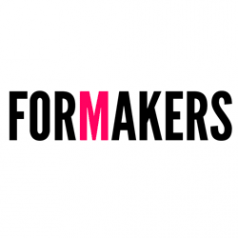10MAR 2015
 © Marc Fornes / THEVERYMANYSKIN: Multiple generative steps were developed to form a continuous, structurally performing skin system. An initial topological mesh object, connecting on six distributed anchor points within the space, is submitted to an iterative surface tension process.
© Marc Fornes / THEVERYMANYSKIN: Multiple generative steps were developed to form a continuous, structurally performing skin system. An initial topological mesh object, connecting on six distributed anchor points within the space, is submitted to an iterative surface tension process.
 © Marc Fornes / THEVERYMANY A seventh extra anchor toward the ceiling, not physically connected, is added in order to maximize double curvature along the surface, and therefore embedding inherent stiffness.MORPHOLOGY: Stress flows obtained from structural analysis (for Under Stress) and tensions lines (for Sous Tension) are translated into a vector-field used for directional fitness by a series of distributed “agents”, flowing along the overall morphology.
© Marc Fornes / THEVERYMANY A seventh extra anchor toward the ceiling, not physically connected, is added in order to maximize double curvature along the surface, and therefore embedding inherent stiffness.MORPHOLOGY: Stress flows obtained from structural analysis (for Under Stress) and tensions lines (for Sous Tension) are translated into a vector-field used for directional fitness by a series of distributed “agents”, flowing along the overall morphology.
 © Marc Fornes / THEVERYMANY The non-intersecting trails of the “agents” are eventually materialized into non-linear aluminum stripes, of length equivalent to the “agents”’ lives. These stripes are connected together and held in place with rivets, maintaining a smooth flow of forces along the surface through tangential continuity while describing the overall morphology.
© Marc Fornes / THEVERYMANY The non-intersecting trails of the “agents” are eventually materialized into non-linear aluminum stripes, of length equivalent to the “agents”’ lives. These stripes are connected together and held in place with rivets, maintaining a smooth flow of forces along the surface through tangential continuity while describing the overall morphology.
 © Marc Fornes / THEVERYMANY Such search protocols are used to replace traditional descriptive geometry rule-sets often far too complex on such non-linear morphologies..
© Marc Fornes / THEVERYMANY Such search protocols are used to replace traditional descriptive geometry rule-sets often far too complex on such non-linear morphologies..
 © Marc Fornes / THEVERYMANY
© Marc Fornes / THEVERYMANY
 © Marc Fornes / THEVERYMANY
© Marc Fornes / THEVERYMANY
 © Marc Fornes / THEVERYMANY
© Marc Fornes / THEVERYMANY
 © Marc Fornes / THEVERYMANY
© Marc Fornes / THEVERYMANY
 © Marc Fornes / THEVERYMANY
© Marc Fornes / THEVERYMANY
 © Marc Fornes / THEVERYMANY
© Marc Fornes / THEVERYMANY
Marc Fornes / THEVERYMANY Installations Transform INRIA
Posted in Architecture - Installation by * FORMAKERS
RESEARCH: The lightweight, ultra-thin structures are the result of an on-going research from the studio into custom computational protocols for optimization of surface tension, geometric description for information modeling, and (re)assembly efficiency up to logistics of transportation. © Marc Fornes / THEVERYMANY
© Marc Fornes / THEVERYMANY © Marc Fornes / THEVERYMANY
© Marc Fornes / THEVERYMANY © Marc Fornes / THEVERYMANY
© Marc Fornes / THEVERYMANY © Marc Fornes / THEVERYMANY
© Marc Fornes / THEVERYMANY © Marc Fornes / THEVERYMANY
© Marc Fornes / THEVERYMANY © Marc Fornes / THEVERYMANY
© Marc Fornes / THEVERYMANY
 © Marc Fornes / THEVERYMANY
© Marc Fornes / THEVERYMANY
 © Marc Fornes / THEVERYMANY
© Marc Fornes / THEVERYMANY
 © Marc Fornes / THEVERYMANY
© Marc Fornes / THEVERYMANY
 © Marc Fornes / THEVERYMANY
© Marc Fornes / THEVERYMANY
Comments
No comments
Sign in »



